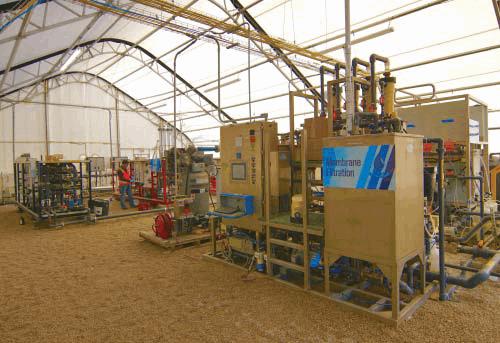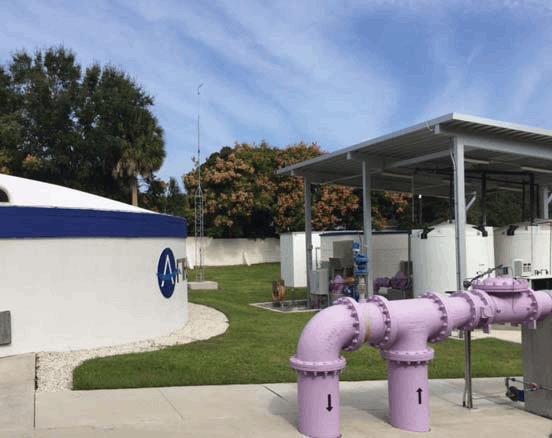Stepping Up Water Reuse — From Irrigation To Direct-Potable
By Christopher P. Hill
Water reuse is trending up. Here are nine developments to watch in 2017.
Water scarcity, both long-term and short-term, is already affecting large parts of the world. Persistent drought and the need for better stormwater management are expected to intensify with climate change and urbanization. Fortunately, with scarcity comes a silver lining: more and better water reuse strategies are taking hold, generating more efficient uses of the water we have.
With the relentless pressure to balance demands for, and supplies of, water for drinking, agriculture, industry, energy, and recreation, water authorities continue to turn to stormwater, graywater, and wastewater reuse to meet the needs of their customers.
While the industry looks globally for answers, utilities can’t ignore local needs and conditions. Thanks to their collective contributions and local adaptations, water reuse continually reinvents itself. Watch these trends for 2017.
1. Reuse is on the rise, especially in California and Florida. In fact, according to a new study forecasting water reuse in the U.S. (http://www.wwdmag.com/ water-recycling-reuse/california-surpass-florida-largestmarket-water-reuse), while Florida may have the most installed capacity, California has enough projects in its pipeline to surpass Florida’s numbers. The study projects that overall, municipal reuse in the U.S. will increase 58 percent by 2026.
The supporting infrastructure for water reuse, from purple pipes to advanced treatment for direct potable systems, will ultimately boost water sustainability for many years. For example, the Arcadis Sustainable Cities Water Index report notes that while no U.S. cities make the top 10 in the water sustainability ranking of 50 cities worldwide, both Los Angeles and San Francisco rank higher than other U.S. and European cities in water reuse. This existing base puts these California cities in a better place to achieve sustainability goals into the future.
2. Potable reuse sets the pace. The big interest now and into the future will be for potable reuse. We’ve figured out how to use water for irrigation. Recycling water for drinking holds even more promise for water-starved communities.
3. Up next: Direct potable reuse. The industry’s goal — making direct potable reuse (DPR) feasible, reliable, safe, and accepted — is a work in progress, but one that makes headway every day. According to the California Direct Potable Reuse Initiative’s “Reporting on significant progress,” the studies sponsored by WateReuse and WateReuse California, creating the foundation for economic considerations, treatment regulations, safety standards, and operational protocols will better enable DPR to be employed in California.
4. Proven in El Paso. To address peak summer needs, the El Paso Water Utility (EPWU) tested the feasibility of direct potable reuse, and is now on track to bring a fullscale system online. Arcadis conducted a pilot test to establish treatment criteria, and identified the treatment protocols that would meet or exceed all standards and regulations.

Pilot testing for EPWU’s planned Advanced Water Purification Facility
Now the utility is developing a DPR system to recycle 10 MGD of treated secondary clarifier wastewater effluent to supplement the city’s current drinking water supplies. The full-scale system will provide ongoing data that can optimize DPR design elsewhere.
5. Reuse of stormwater and graywater continues to expand and adapt. Not to be ignored, the popularity of graywater and stormwater reuse will fuel projects on multiple levels, often solving multiple problems at once. Thinking has shifted from “Can we do this?” to “Here’s how we’ll do this.” For example:
- Florida A-FIRST project — Runoff for irrigation, Altamonte Springs, FL
Located near Orlando, FL, Altamonte Springs took a holistic approach to both stormwater management and water supply for irrigation. To increase supply, relieve use of its aquifer, and manage runoff from highway I-4, the city developed the first stormwater capture from highway I-4 to be used for irrigation. The new Altamonte Springs-FDOT Integrated Reuse and Stormwater Treatment (A-FIRST) redirects up to 6 MGD of captured stormwater for irrigation — 1.5 MGD to the city and another 4.5 MGD to the neighboring city of Apopka — to reduce pumping from the aquifer and eliminate up to 3 MGD of peak flow to the Little Wekiva River. In addition, the project eliminates the need for more stormwater retention ponds, which in the past could allow pollutants to seep into groundwater. - Los Angeles Urban Stormwater – River as green infrastructure, City of Los Angeles, CA
In a win-win for the city, the Los Angeles Stormwater program combines flood control and pollution reduction to monitor and reduce pollutants in stormwater runoff. The Los Angeles River Revitalization Master Plan looks forward to the day when, rather than channeling stormwater to the ocean from its many iconic viaducts, the LA River will start to return to a natural environment, supporting recreation and water quality as well as stormwater control. This effort builds on others aiming to rebalance the proportion of LA water that comes from imported supply, and to recycle larger volumes of water for local and regional use.

Recycled water flow via purple pipes at the treatment plant
6. Planners are re-thinking irrigation as a reuse application. Even as reuse for irrigation continues to expand, the rise of potable reuse technology raises an important question: After all that cost and treatment, is irrigation the best application for recycled water? The thinking is that water is too precious and should be used for a higher purpose — drinking water.
7. Costs are making the purple pipes less practical. While the concept of reusing graywater remains very popular, the cost of implementation remains a barrier. The main trouble is that cities were not designed with purple pipes, or those marked for recycled water, and the retrofit can be cost-prohibitive.
8. Ongoing research and discovery: Understanding health and environmental impacts. Research will help answer questions like how to reduce viral pathogens and develop guidelines for treatment to prove feasibility of potable reuse as a regular practice.
For example, between now and 2018, the Water Research Foundation (WRF) is conducting a new study to provide guidelines and requirements for water reuse to protect public health: “Conventional Drinking Water Treatment of Alternative Water Sources: Source Water Requirements.” This research will develop quality parameters, objectives, and treatment protocols for the design, operations, and monitoring of incorporating alternative sources into drinking water supplies.
9. Regulations remain regional. Policies and regulations for reuse will continue to address local needs. On one hand, Arizona prohibits direct potable reuse by law. On the other, Florida is changing its law for recycled water to make it more viable. Local conditions reign. We may never see federal standards or regulations since these would have to address a national need and more universal conditions.
About The Author
 Christopher Hill, PE, BCEE, ENV SP, is a vice president of Arcadis, the Water Supply & Treatment Lead for North America, and a board member of the Water Environment & Reuse Foundation. He has 24 years of experience as a drinking water expert, applying innovative vision and proven technical expertise to more than 100 projects for cities and communities around the world. Chris has a keen understanding of the water cycle, which includes wastewater treatment and resource recovery, and is recognized as a thought leader in alternative water supply solutions such as reuse and desalination.
Christopher Hill, PE, BCEE, ENV SP, is a vice president of Arcadis, the Water Supply & Treatment Lead for North America, and a board member of the Water Environment & Reuse Foundation. He has 24 years of experience as a drinking water expert, applying innovative vision and proven technical expertise to more than 100 projects for cities and communities around the world. Chris has a keen understanding of the water cycle, which includes wastewater treatment and resource recovery, and is recognized as a thought leader in alternative water supply solutions such as reuse and desalination.
